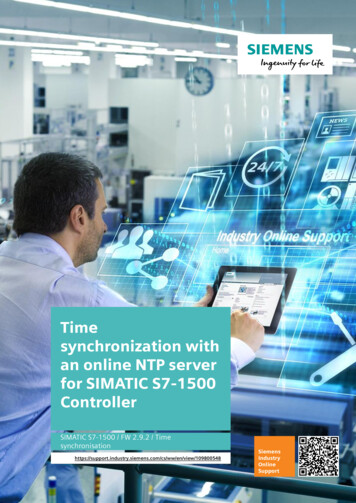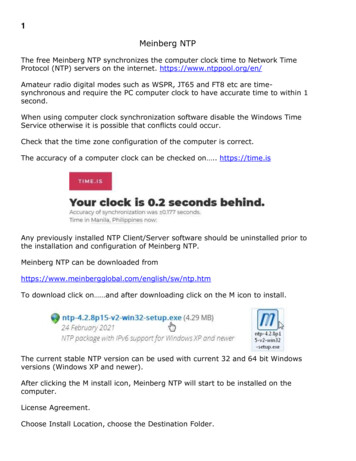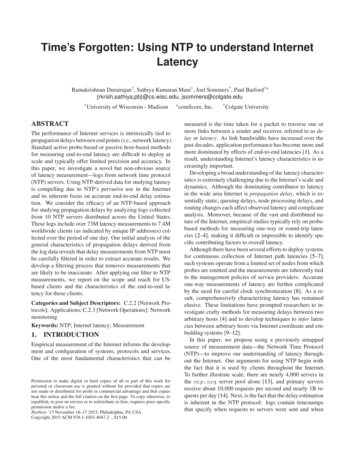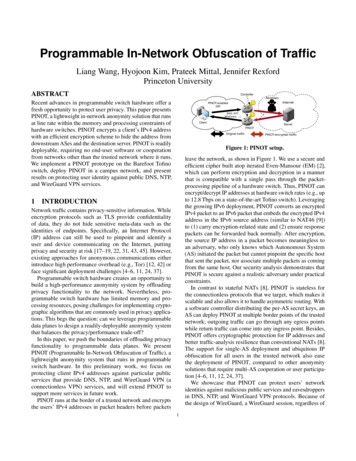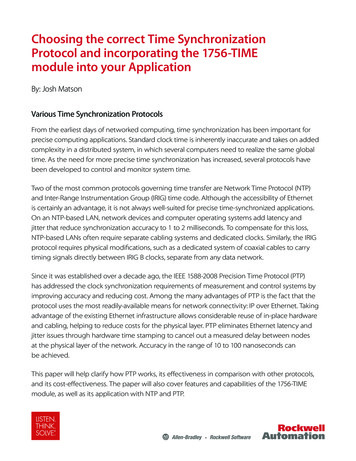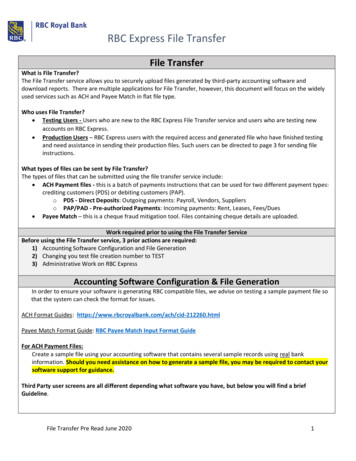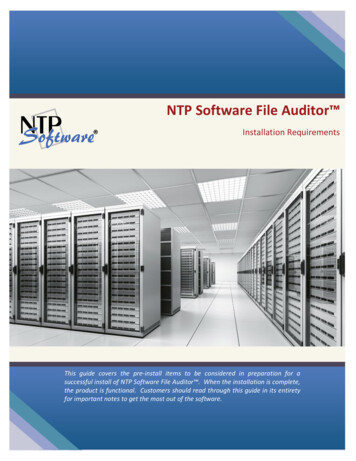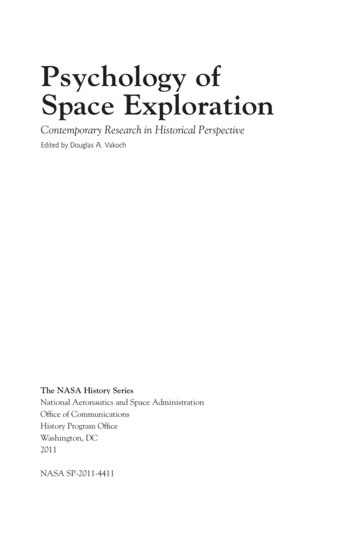
Transcription
Time Transfer in SpaceDavid L. MillsUniversity of Delawarehttp://www.eecis.udel.edu/ millsmailto:mills@udel.eduSir John Tenniel; Alice’s Adventures in Wonderland,Lewis Carroll22-Sep-081
Experiments on NTP time transfer in spaceoThere were many cases in the early NSFnet where NTP clocks weresynchronized over satellite (VSAT) terminals. With two-way satellitelinks resutls were very satisfactory. However, results with mixedterrestrial/satellite links were generally unacceptable.oIn the early 1980s and again in 2000 there was an NTP time transferexperiment aboard an AMSAT Oscar spacecraft in low Earth orbit. Theresults showed little effects of satellite motion and Doppler.oThere was an NTP time transfer experiment aboard Shuttle missionST-107 (Columbia). The results showed fair accuracy in the lowmillisecond range, but some disruptions due to laptop problems andoperator fatigue.oNational Public Radio (NPR) now distributes program content and timesynchronization via TCP/IP and NTP.oThe Constellation Moon exploration program is to use NTP.o22-Sep-082
Time transfer between stations on Earth via satelliteoEach station sends a pulse and starts its counter. It stops thecounter when a pulse is received.oEach station sends the counter value to the other station.oThe station clock offset is th difference between the counters.22-Sep-083
70-MHz analog IF22-Sep-084
Linear feedback shift register generatoroThe taps represent a primative polynomial over GF(2).oIt generates a binary sequence (chip) of 65535 bits with excellentautocorellation properties.oThe chips are modulated on a carrier in BPSK, one bit per chipand N bits per word. A one is an upright chip; a zero is an invertedchip.oThe chipping rate is chosen so that for some number M, MN isexactly one second.oThe first word in the second contains a unique code.22-Sep-085
Time transfer to Shuttle via TDRSS22-Sep-086
Time transfer to the Moon (simulation)TimeRound-trip Time Measured by ClientTC-OrgClientClient originate timeServer Receive timeServer transmit timeOS QueuingDelayClient’s packet receive timeClient receive time1192 Kbps2Clocking Delay(3.75 ms.)TC-RcvNTP packet receivedNTP90BFEC Codeblock(1115B)(46.5 ms.)311OS QueuingDelay10PathPropagationDelay(250 ms.)PathPropagationDelay4(250 ms.)864 Kbps9Clocking Delay(11.25 ms.)5OS QueuingDelayClientOS QueuingDelay7ServerNTP90BFEC Codeblock(1115B)(140 ms.)TS-Rcv Server Turnaround TS-Xmit22-Sep-08Delay(.1 ms.)67
Time transfer from DSN to Mars orbiter22-Sep-088
Solar system time transfer22-Sep-089
Mars orbiters and landers22-Sep-0810
Mars exploration rovers (MER)22-Sep-0811
NASA/JPL deep space network (DSN)oDSN stations at Goldstone (CA), Madrid (Spain) and Canberra(Austrailia) controlled from JPL (Pasadena, CA).oAppproximate 120-deg apart for continuous tracking andcommunicating via TDRSS.oAntennas: 70-m parabolic (1), 34-m parabolic, (3-5), 12-m X-Y (2-3)oPlans 12-m parabolic array (400).22-Sep-0812
DSN 70-meter antenna at Ka bandoPo 400 kW 56 dBW Antenna: f 32 GHz, D 70 m; G 82 dBoERP 138 dBW or 7 TW!22-Sep-0813
Other DSN antennaso34-m enhanced beamwaveguide antenna (EBWA).o0.1-10 Mbps Ka band at MarsoEach station has three of these.22-Sep-08oArray of 360 12-m antennas.o10-500 Mbps Ka band at MarsoPlanned for all three stations.14
Downlink data rate22-Sep-08oUHF (Mars only)up 435-450 MHzdown 390-405 MHzband 15 MHzoS bandup 2110-2120 MHzdown 2290-2300 MHzband 10 MHzoX bandup 7145-7190 MHzdown 8400-8450 MHzband 50 MHzoKa bandup 34.2-34.7 GHzdown 31.8-32.3 GHzband 500 MHz15
Spectrum congestion at X band22-Sep-0816
The devil is in the detailsoProper time: time measured on the suface or in orbit about aprimary body.oBarycentri time: time measured at the point of zero gravity of theorbiter and primary body.oTime is transferred from GPS orbit to Earth surface, then via Earthbarycenter, solar system barycenter, Mars barycenter and propertime at Mars orbiter.oThe calculations may need systematic corrections for Gravitional potential (red shift) Velocity (time dilation) Sagnac effect (rotating frame of reference) Ionospheric corrections (frequency dependent)22-Sep-0817
Coordinate conversionsThree relativistic effects contribute todifferent “times”:(1) Velocity (time dilation)(2) Gravitational Potential (red shift)(3) Sagnac Effect (rotating frame ofreference)Proper time asmeasured byclocks on MarssurfaceMars SpacecraftMarsSo how do we adjust from one timereference to another? Proper time asmeasured byclock on MarsspacecraftMars to EarthCommunicationsGPS SatelliteBarycentricCoordinate Time(TCB)22-Sep-08SunProper time asmeasured byclock on GPSsatelliteEarthProper time asmeasured by clockson Earth’s surface18
Inner planet orbits22-Sep-0819
Facts of lifeoThe Mars day is about one Earth day plus 40 m. Its axis is inclineda bit more than Earth, so Mars has seasons.oThe Mars year is about two Earth years; the closest approach toEarth is every odd Earth year.oIt takes about a year to get to Mars, decelerate and circulaize theorbit, then a few weeks to entry, descent and land (EDL).oNASA orbiters are in two-hour, Sun-synchronous, polar orbits, sothe pass a lander twice a day, but only for about ten minutes eachpass.oDuring one pass commands are uploaded to the spacecraft;during the other telemetry and science data are downloaded to theorbiter and then from there to Earth.oAbout 80 megabits can be downloaded on each pass at rates up to256 kbps.22-Sep-0820
22-Sep-0821
Planetary orbits and Lagrange pointsoSomething is always in orbit about something else.oThe orbiter is almost always very tiny with respect to the orbited(primary) body.oAdd energy at periapsis to increase the apoapsis and vice versa.oAdd energy at apoapsis to increase the periapsis and vice versa.oLose energy to at apohelion for Mars orbit capture and aerobrake.22-Sep-0822
Time transfer to the Moon22-Sep-0823
Keplerian elemente for Hubble Space TelescopeoSatellite: HUBBLECatalog number: 20580Epoch time: 08254.95275816Element set: 0219Inclination: 028.4675 degRA of node: 123.8301 degEccentricity: 0.0003885Arg of perigee: 212.6701 degMean anomaly: 147.3653 degMean motion: 15.00406242 rev/dayDecay rate: 3.50e-06 rev/day 2Epoch rev: 80787 Checksum: 282oIn practice the elements can be determined by the state vectors(range and range rate) at three different times along the orbit.22-Sep-0824
Range and range rate measurementsoKeplerian elements are determined from three range and rangerate measurments.oRange must be determined to 3 ns and range rate (doppler) to lessthan 1 Hz. This requires extraordinary oscillator stability at DSNstations.oGood satellite oscillator stability is difficult and expensive .oTracking times can be long – up to 40 m.oSolution is strict coherence between uplink and downlink signals.oDSN station handover must be coherent as well.22-Sep-0825
Numeric-controlled oscillator (NCO)1248LookupTable(12)DAC300 / (248 / N) MHz300 MHzPhase Acumulator (48)4848PpreviousACCPhaseIncrementLoad N (48)oThis device can synthesize frequencoes in tha range 0-75 MHzwith preicion of about 1 mHz. It works by dividing a 300-MHz clockby an integral value in the range 1-246.oThe Analog Devices AD 9854 chip includes this NCO together witha BPSK/QPSK modulator, sweepe generator, 20x clock multiplierand amplitude control.oThe lookup table includes ¼ cycle of sine-wave samples. Thehigh-order two bits map this table to all four analog quadrants.22-Sep-0826
Range rate turnaround70 MHzLNASSBMixerIF25 MspsADCCarrierTrackingLoopfuX bandAntennaNCO1DiplexorLoopFilterR 749 / 880fdRFPANCO2DigitaloThe digital carrier tracking loop locks NCO1 on the receivedcarrier at 70-MHz IF.oThe phase increment of NCO2 is calculated from the given ratio Rat the 70-MHz IF.oThe DSN calculates the range rate fr ½ (fu – 1/R fd)22-Sep-0827
Non-regenerative range turnaround70 MHzLNASSBMixerIF25 MspsADCCarrierTrackingLoopfuX bandAntennaNCO1DiplexorLoopFilterR 749 / 880RFNCO2fdPADigitalSSBMixeroThis is often called a bent pipe.oThe digital carrier tracking loop locks NCO1 on the receivedcarrier .oThe IF is filtered and upconverted by NCO2 to the downlinkfrequency.o22-Sep-08The DSN calculates the range from the PN signal.28
Regenerative range turnaround70 MHzLNASSBMixerIF25 MspsADCCarrierTrackingLoopfuX bandAntennaLoopFilterNCO1DiplexorR 749 / 880RFNCO2fdDigital25 ar to bent pipe, except the PN signal is recovered, filteredand remodulated on the downlink.oThis improves the SNR at the DSN by about 17 dB.22-Sep-0829
Electra transceiveroThere are three Electra radios Original Electra for MRO (7 W) Electra LITE for Phoenix (7 W; lightweight) Electra MICRO for balloons (100 mw)22-Sep-0830
Design featuresoThis is a software defined digital radio that can be reconfiguredvia the data link. It operates at UHF frequencies ( 400 MHz) atvariable symbol rates to 4.096 MHz.oIt uses Reed Solomon, convolutional encoding and 3-bit softViterbi decoding.oIt can operate with either NRZ or Manchester encoding usingeither a Costas loop (NRZ) or PLL (Manchester) carrier trackingloop.oIt uses a concatenated integrate-comb (CIC) decimator, digitaltransition tracking loop (DTTL) for symbol synchronization.oAll this with no DSP chip and an absolutely humungus FPGA.oAn onboard computer implements a reliable link protocol withCRC and state machine.oIncluding a 300 K ultra-stable oscillator, it ain’t cheap.
Block diagram22-Sep-0832
Concatenated integrate-comb decimator22-Sep-0833
Costas carrier tracking loop22-Sep-0834
Block diagram of Costas/PLL carrier tracking loop22-Sep-0835
Digital transition tracking lop (DTTL)oThe DTTL uses three integrators, where the symbol time is T A 0-T/2 for the signal. B T/2-T for the signal and and first half of the transition. C T-3T/2 for the second half of the transitionoThe symbol is A B.oThe phase is B C processed by a loop filter and NCO.22-Sep-0836
DTTL symbol synchronization22-Sep-0837
Electra decimation vs. time resolution22-Sep-0838
Digital modulator22-Sep-0839
Further informationooooNTP home page http://www.ntp.org Current NTP Version 3 and 4 software and documentation FAQ and links to other sources and interesting placesDavid L. Mills home page http://www.eecis.udel.edu/ mills Papers, reports and memoranda in PostScript and PDF formats Briefings in HTML, PostScript, PowerPoint and PDF formats Collaboration resources hardware, software and documentation Songs, photo galleries and after-dinner speech scriptsUdel FTP server: ftp://ftp.udel.edu/pub/ntp Current NTP Version software, documentation and support Collaboration resources and junkboxRelated projects http://www.eecis.udel.edu/ mills/status.htm Current research project descriptions and briefings22-Sep-0840
The devil is in the details o Proper time: time measured on the suface or in orbit about a primary body. o Barycentri time: time measured at the point of zero gravity of the orbiter and primary body. o Time is transferred from GPS orbit to Earth surface, then via Earth barycenter, solar system barycenter, Mars barycenter and proper time at Mars orbiter.
